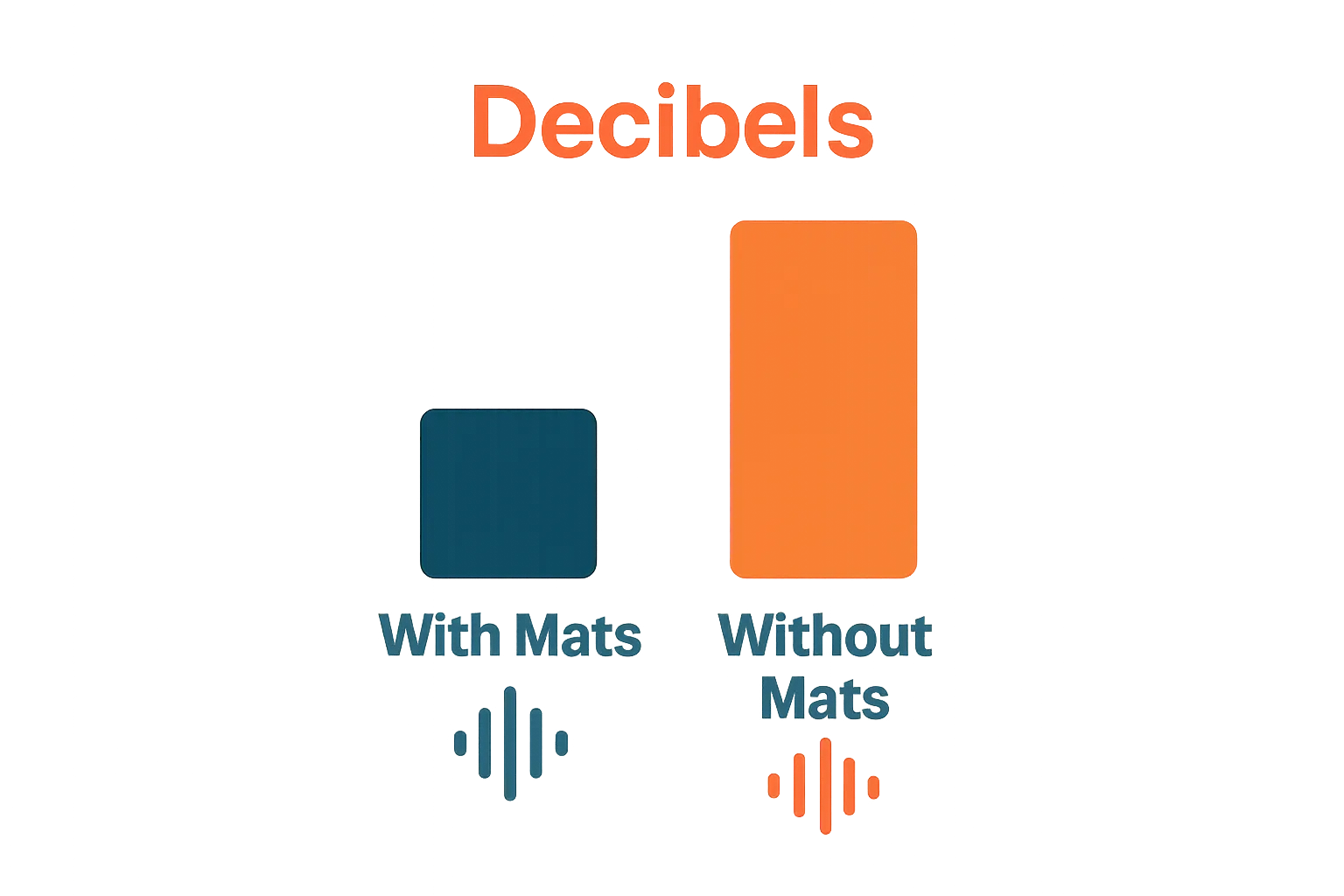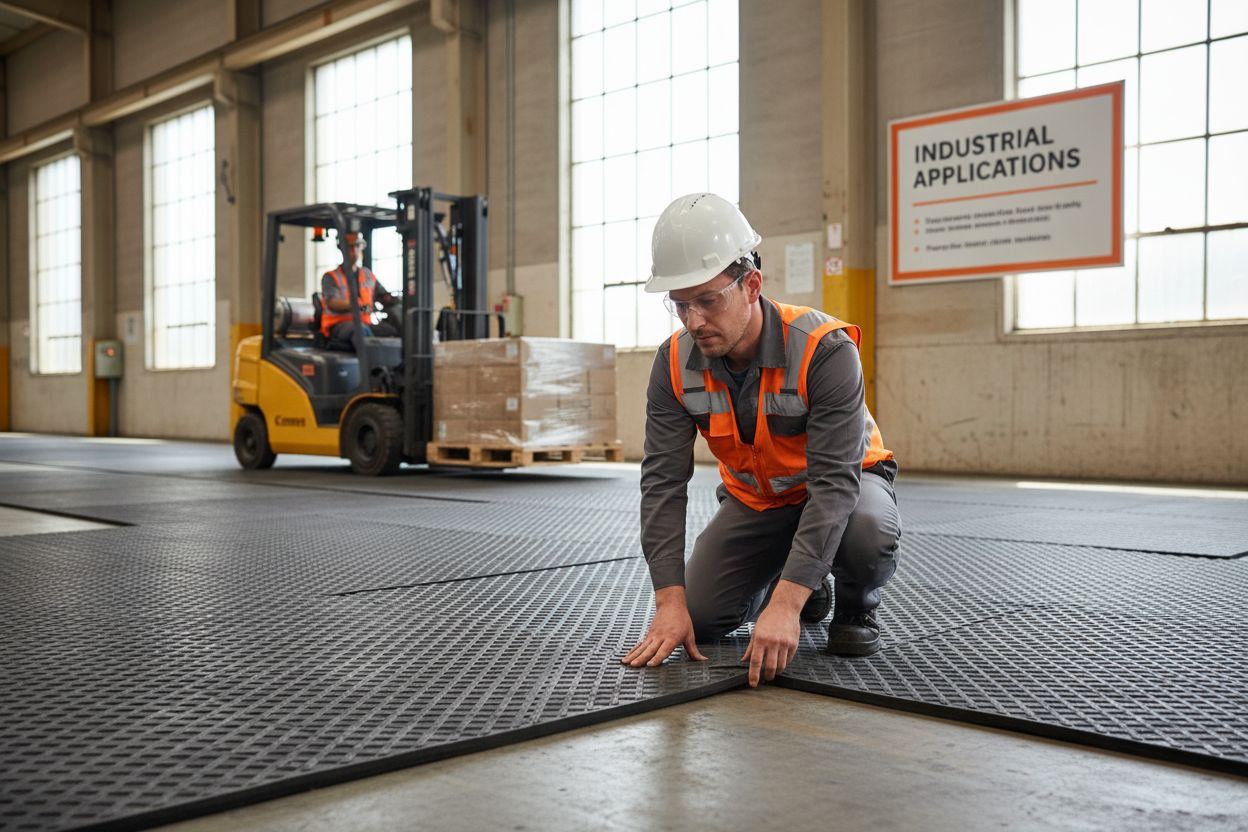Noise from foot traffic, machinery and even conversation can turn any busy space into a source of constant distraction. The surprising part is that simply adding a mat can change everything. Some noise reduction floor mats have been shown to reduce worker productivity loss due to noise by up to 20 percent according to the World Health Organization but it is not just about quiet. The real value comes from the impact on wellbeing, focus and even physical health that most people never consider.
Table of Contents
- What Are Noise Reduction Floor Mats?
- The Importance of Noise Reduction in Various Settings
- How Noise Reduction Floor Mats Work
- Materials and Technologies Used in Noise Reduction Mats
- Practical Applications of Noise Reduction Floor Mats
Quick Summary
| Takeaway | Explanation |
|---|---|
| Noise reduction mats mitigate sound pollution | These mats are engineered to absorb sound waves and reduce noise levels in various environments. |
| They enhance workplace productivity and wellbeing | Effective acoustic management leads to improved concentration and lower stress levels among workers. |
| Proper installation maximises their effectiveness | Correct placement and coverage are crucial for optimal sound absorption in any space. |
| Suitable for multiple environments | These mats are beneficial in offices, healthcare, education, and industrial settings. |
| Advanced materials are key to performance | High-density materials are specifically designed to capture and neutralise sound waves efficiently. |
What Are Noise Reduction Floor Mats?
Noise reduction floor mats are specialised engineering solutions designed to mitigate acoustic disturbances in professional and industrial environments. These advanced matting products serve a critical function in managing sound transmission and impact noise across various settings, from busy office spaces to high traffic commercial facilities.
The Science of Sound Absorption
At their core, noise reduction floor mats leverage sophisticated acoustic engineering principles. These mats are constructed using dense, sound-absorbing materials that effectively dampen and dissipate acoustic energy. By intercepting sound waves generated through foot traffic, equipment movement, and structural vibrations, these mats significantly reduce noise pollution.
The primary mechanisms of sound reduction include:

- Absorbing vibrational energy through dense, resilient material compositions
- Creating a physical barrier that interrupts sound wave transmission
- Preventing direct contact between hard surfaces that amplify noise
Applications and Performance Characteristics
Noise reduction floor mats are not merely functional accessories but strategic acoustic management tools. According to Health and Safety Executive guidance on workplace noise, these mats play a significant role in creating more comfortable and productive working environments.
Their applications span multiple sectors, including:
- Corporate office spaces with open plan layouts
- Industrial manufacturing facilities
- Gymnasium and fitness centres
- Educational institutions
- Healthcare environments
By reducing noise transmission and improving acoustic comfort, these mats contribute to enhanced workplace wellbeing, improved concentration, and reduced stress levels for occupants.
Understanding the intricate design and performance of noise reduction floor mats reveals their importance beyond simple floor covering. They represent a sophisticated solution to managing acoustic environments, transforming spaces through intelligent material science and strategic sound management techniques.
The Importance of Noise Reduction in Various Settings
Noise reduction strategies play a pivotal role in creating healthier, more productive environments across numerous professional and personal spaces. Understanding how excessive sound impacts human performance and wellbeing is crucial for implementing effective acoustic management solutions.
Workplace Productivity and Performance
In modern professional environments, ambient noise can significantly diminish cognitive function and workplace efficiency. Research from the World Health Organization indicates that persistent background noise can reduce worker productivity by up to 20% through increased stress, reduced concentration, and heightened cognitive load.
Key performance impacts of unmanaged noise include:
- Decreased cognitive processing speed
- Increased mental fatigue
- Higher error rates in complex tasks
- Reduced communication effectiveness
- Elevated stress hormone levels
Health and Psychological Implications
Chronic noise exposure extends beyond mere workplace disruption, presenting substantial health risks. Prolonged acoustic stress can trigger physiological responses that compromise mental and physical wellbeing. Sustained high noise levels are associated with elevated blood pressure, compromised immune responses, and potential long term cardiovascular complications.
Educational and Learning Environments
In academic settings, noise reduction becomes critically important for student learning and comprehension. Educational acoustics research demonstrates that controlled acoustic environments can improve student concentration, reduce learning fatigue, and enhance overall educational outcomes.
By strategically implementing noise reduction solutions, organisations can transform their spaces into more harmonious, productive environments that support human performance and wellbeing. The investment in acoustic management represents a sophisticated approach to creating optimal working and learning conditions.
Below is a table summarising the different environments where noise reduction mats are used and their key benefits in each setting.
| Environment | Typical Application Areas | Key Acoustic Benefits |
|---|---|---|
| Industrial/Manufacturing | Machinery zones, workstations, corridors | Reduces mechanical noise, enhances worker comfort |
| Educational Institutions | Classrooms, libraries, lecture theatres | Supports concentration, improves learning outcomes |
| Healthcare Facilities | Hospital corridors, rehab centres | Minimises patient stress, supports recovery |
| Commercial Offices | Reception, meeting rooms, work areas | Improves focus, lowers distractions |
| Fitness/Gym Facilities | Workout zones, weight areas | Damps impact noise, protects hearing |
How Noise Reduction Floor Mats Work
Noise reduction floor mats employ sophisticated acoustic engineering principles to systematically interrupt and absorb sound waves, transforming potentially disruptive acoustic environments into more controlled, comfortable spaces. Understanding their intricate functionality reveals the complex science behind these remarkable acoustic management solutions.
Material Composition and Sound Absorption
The core mechanism of noise reduction floor mats lies in their advanced material engineering. These mats are constructed using multilayered composites specifically designed to capture and dissipate acoustic energy. Acoustic engineering research demonstrates that materials with high density and cellular structures are most effective in sound wave attenuation.
Key material characteristics include:
- High porosity allowing sound wave penetration
- Dense internal structures for maximum energy conversion
- Resilient compositions that maintain structural integrity
- Specific molecular arrangements that interrupt sound transmission
Vibrational Energy Conversion
Noise reduction floor mats function through a process called acoustic impedance transformation. When sound waves contact the mat surface, the material converts kinetic energy into minute thermal variations, effectively neutralising potential noise transmission. This process involves complex interactions between sound wave frequencies and material molecular structures.
Installation and Acoustic Performance
Precise installation plays a critical role in maximising noise reduction effectiveness. Learn more about proper mat installation techniques to ensure optimal acoustic performance. Strategic placement and comprehensive coverage are essential for creating comprehensive sound management solutions across various environments.
The sophisticated engineering behind noise reduction floor mats represents a nuanced approach to acoustic management, transforming potential sonic disturbances into controlled, comfortable spatial experiences through intelligent material science and strategic design principles.
Materials and Technologies Used in Noise Reduction Mats
The effectiveness of noise reduction floor mats hinges on advanced material science and sophisticated acoustic engineering technologies. These innovative solutions represent a convergence of specialised materials, cutting edge design principles, and precise sound management strategies.
Acoustic Absorption Materials
Nowadays, noise reduction mats incorporate a range of high performance materials specifically engineered to intercept and neutralise sound waves. Acoustic research from UK engineering institutes highlights the critical importance of material selection in sound management.
Key material technologies include:
- Closed cell foam composites
- Rubber and synthetic polymer blends
- Viscoelastic materials with energy dissipation properties
- Multi layered molecular structures
- Advanced recycled rubber compounds
Molecular Design and Sound Wave Interruption
The molecular architecture of noise reduction mats plays a crucial role in their acoustic performance. Sophisticated molecular engineering enables these materials to transform sound energy through complex impedance transformations, converting kinetic vibrations into minimal thermal variations.
Specific technological approaches involve:
- Strategically designed cellular structures
- Molecular arrangements that maximise sound wave interference
- Precise density gradients within material compositions
- Engineered porosity for optimal acoustic absorption
Performance Enhancement Technologies
Modern noise reduction mats integrate additional performance enhancement technologies beyond basic sound absorption. Explore advanced dust control mat technologies that complement acoustic management strategies, demonstrating the multifunctional potential of contemporary mat engineering.
These innovative materials represent a sophisticated approach to environmental noise management, transforming acoustic spaces through intelligent design and precise material science principles.
This table provides an at-a-glance comparison of core material technologies used in noise reduction floor mats and their primary acoustic functions.
| Material Type | Description | Acoustic Function |
|---|---|---|
| Closed cell foam composites | High density, minimal open pores | Absorbs and traps airborne noise |
| Rubber & synthetic polymers | Blended layers with elastic properties | Damps vibrations and impact noise |
| Viscoelastic materials | Flexible, energy dissipating composition | Converts kinetic energy to heat |
| Advanced recycled rubber | Eco-friendly, durable multi-layer construction | Enhances sound blockage and absorption |
Practical Applications of Noise Reduction Floor Mats
Noise reduction floor mats provide versatile acoustic management solutions across diverse professional and institutional environments. Their strategic implementation addresses complex sound transmission challenges while enhancing spatial comfort and operational efficiency.
Industrial and Manufacturing Environments
In high intensity industrial settings, noise reduction floor mats play a critical role in mitigating acoustic stress. Manufacturing facilities, warehouses, and production lines generate substantial mechanical noise that can compromise worker wellbeing and productivity. Research from UK occupational health studies indicates that targeted acoustic interventions can significantly improve workplace performance and employee health.
Key industrial applications include:
- Machinery operation zones
- Assembly line workstations
- Forklift and equipment movement corridors
- High traffic manufacturing areas
- Precision engineering workshops
Educational and Healthcare Spaces
Noise reduction technologies extend beyond industrial contexts into sensitive environments like educational institutions and healthcare facilities. Controlled acoustic environments are crucial for concentration, patient recovery, and overall spatial functionality.
Strategic noise management applications encompass:
- Classroom and lecture theatre floors
- Hospital corridors and treatment areas
- Research laboratory spaces
- Rehabilitation and physiotherapy centres
- Library and study environments
Commercial and Office Implementations
Modern open plan offices and commercial spaces increasingly recognise the importance of acoustic management. Learn more about maintaining professional mat environments to ensure optimal performance and longevity of noise reduction solutions.
Commercial noise reduction strategies target:
- Reception and waiting areas
- Conference and meeting rooms
- Shared workspace zones
- Customer interaction spaces
- Technical workstations
These sophisticated noise reduction floor mats represent more than simple floor coverings. They are intelligent acoustic engineering solutions that transform environmental soundscapes, enhancing human performance and comfort across multiple professional domains.

Discover Real Acoustic Comfort with Specialist Mats
If unwanted noise is making concentration difficult or disrupting sensitive environments, you do not have to struggle with poor acoustics. The article highlighted how noise reduction floor mats use advanced materials and engineering to create a quieter, more productive space. That means less distraction, less stress, and a stronger focus for everyone present. Whether you are managing a busy hospital, a demanding retail environment, or any professional setting where sound control is vital, you deserve a solution designed to tackle noise right at the source.
Experience the practical benefits of tailored matting solutions by exploring our Hospital Mats | Matting for Medical Facilities and Retail Industry Mats collections. Both ranges feature noise reduction technologies that support the wellbeing and comfort of every user.

Now is the moment to take charge of your environment and create a calmer, safer atmosphere for staff and visitors. Visit Mats4U to find mats that match your exact requirements. Choose proven acoustic comfort and transform the soundscape of your workplace today.
Frequently Asked Questions
What are noise reduction floor mats?
Noise reduction floor mats are specialised solutions designed to minimise acoustic disturbances in various environments by absorbing sound waves generated from foot traffic, equipment movement, and structural vibrations.
How do noise reduction floor mats work?
These mats utilise dense, sound-absorbing materials to intercept and dissipate acoustic energy, transforming disruptive sound environments into quieter, more comfortable spaces through mechanisms like vibrational energy absorption and sound wave interruption.
What are the primary applications for noise reduction floor mats?
Noise reduction floor mats are used in a range of environments, including corporate offices, industrial manufacturing facilities, gymnasiums, educational institutions, and healthcare settings, to enhance acoustic comfort and improve workplace wellbeing.
Can noise reduction floor mats improve workplace productivity?
Yes, implementing noise reduction mats can significantly reduce ambient noise levels, which may enhance cognitive function, reduce stress, and improve overall workplace efficiency, as excessive noise has been linked to decreased productivity and increased mental fatigue.









